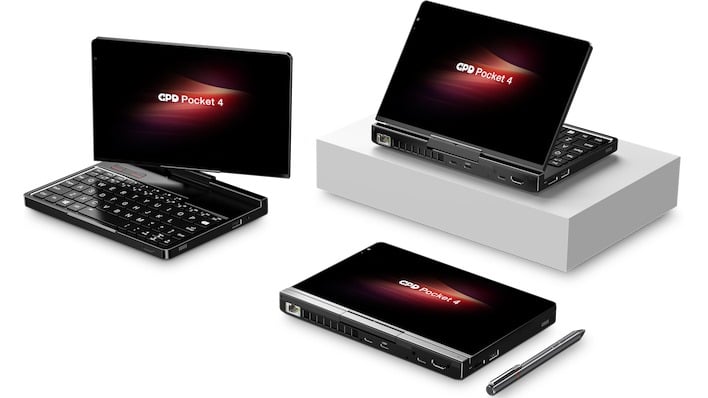Have you ever wished you could use your smartphone as your primary PC? There are various ways to achieve that, but how about this instead: the GPD Pocket 4. This is a handheld PC with an 8.8″ screen. That puts it on the high end of “phablet” size, yet still arguably pocketable. Despite the small size, it comes equipped with a twelve-core AMD Ryzen AI 9 HX 370 SoC, a 144-Hz QHD+ display, up to 64GB of RAM, and M.2 SSDs up to 4TB.
To be clear, this is not a gaming handheld. This device doesn’t compete with machines like the ROG Ally or the Legion Go because it does not have gaming controls built-in. It also doesn’t have large grips on the back, allowing it to be shockingly svelte. GPD says that the Pocket 4 is 22mm thick, although we think that’s referring to the base, not the overall machine, which our pixel-counting presents as more like 35mm thick.

GPD Pocket 4 compared against iPhone 15 Pro Max.
Here you can see a comparison of the Pocket 4 against the iPhone 15 Pro Max. Given this comparison, it’s not really pocket-sized unless you’re wearing some baggy cargo shorts. Still, it’s pretty damn small considering the specifications: a twelve-core Ryzen AI 9 HX 370 processor with sixteen-core RDNA 3.5 GPU, up to 64GB of LPDDR5X-7500 memory, and up to 4TB of PCIe 4.0 x4 NVMe storage. This machine is a beastie.
That’s without even mentioning the impressive 2560×1600 IPS LCD with a 144-Hz refresh rate and 97% coverage of DCI-P3, or the robust external connectivity: HDMI 2.1, USB 4, dual USB 3.2 Gen2 (10 Gbps), and a single USB 2.0-A port comprise the primary connections. There’s also 2.5-Gigabit Ethernet, Wi-Fi 6E, Bluetooth 5.3, and a 3.5mm audio jack.

We’d be remiss not to mention the cool modular accessory bay, though. You can slot in one of four modules depending on what function the GPD Pocket 4 is serving, giving you access to a fast MicroSD card reader, an RS-232 serial port, a 4G LTE WAN modem, or a “KVM module” that lets your Pocket 4 serve as keyboard, trackpad, and display for another system. That could be very useful for troubleshooting headless servers.

The GPD Pocket 4 has active stylus support, which includes the Surface Pen—although it doesn’t come with its own stylus in the box. There’s a fingerprint sensor on the power button, and the keyboard is a full QWERTY type with chiclet-style keys that are white backlit. The touchpad supports gestures, and there’s even a 3-axis accelerometer in the device even though it isn’t intended for gaming.

Of course, you COULD game on it, and GPD presents the fascinating benchmark above, comparing the Strix Point chip’s Radeon 890M in 3DMark Time Spy against an “Intel Core Ultra 7 268V” processor and its “Arc 140V” integrated graphics. What is an Intel Core Ultra 7 268V? Your guess is as good as ours, but it’s presumably a Lunar Lake chip. The Lunar Lake part puts up a good fight against the GPD Duo, but we have to note that these chips are configured for 45W, while the GPD Pocket 4 maxes out at 28W of cooling. Kinda shady, GPD.

With all these features, how much is the thing going to cost? Well, GPD hasn’t revealed that critical detail yet. However, it’s not going to be cheap. Given the cutting-edge Strix Point SoC, the high-end specifications, and the all-aluminum unibody construction, we’d be surprised if the GPD Pocket comes in under $1500.

